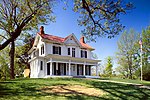Carver Theater (Washington, D.C.)
1948 establishments in Washington, D.C.African-American history of Washington, D.C.AnacostiaCinema of Washington, D.C.Cinemas and movie theaters in Washington, D.C. ... and 4 more
Former cinemas in the United StatesStreamline Moderne architecture in Washington, D.C.Theatres completed in 1948Unused buildings in Washington, D.C.

The Carver Theater is a former movie theater located in the Anacostia neighborhood of Washington, D.C. in the United States.
Excerpt from the Wikipedia article Carver Theater (Washington, D.C.) (License: CC BY-SA 3.0, Authors, Images).Carver Theater (Washington, D.C.)
Martin Luther King Junior Avenue Southeast, Washington
Geographical coordinates (GPS) Address Nearby Places Show on map
Geographical coordinates (GPS)
| Latitude | Longitude |
|---|---|
| N 38.86284 ° | E -76.99275 ° |
Address
King City Restaurant and Carry out
Martin Luther King Junior Avenue Southeast 2403
20020 Washington
District of Columbia, United States
Open on Google Maps






